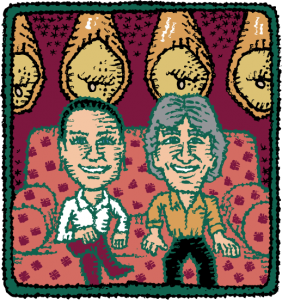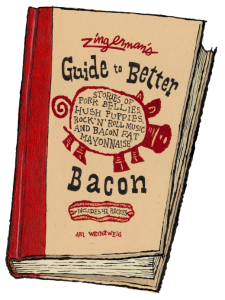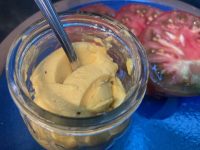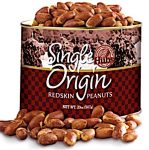An Interview with Herb Eckhouse
Ari recently talked with cured pork producer Herb Eckhouse, founder of La Quercia, about Iowa, pancetta, and the history of the Tamworth Hog .
Herb will be speaking at Zingerman’s 4th Annual Camp Bacon this summer. Please join us!
In Pursuit of World-Class Cured Pork
Herb and Kathy Eckhouse have been curing great air-dried hams, pancetta, guanciale and other fine meats for many years now. I wrote about him extensively in the bacon book—he and I actually went to high school about four miles apart back in suburban Chicago. The Deli sells a wide range of Herb’s really wonderful cured pork products. Their cured hams, lardo, guanciale, pancetta and other pork products have been acclaimed by aficionados all over America. The flavor of everything they make is pretty marvelous and their commitment to sustainable hog raising is pretty inspiring. Herb will be coming to speak at Camp Bacon June 1st!
Ari: Yours are unquestionably some of our favorite cured pork products at Zingerman’s. What are some of the key things that make them so special? 
Herb: It all starts with the pork. That’s 96 percent of what people eat when they eat our cured meats. We are committed to using pork from pigs NOT raised in confinement and that NEVER receive non-therapeutic antibiotics. This is a very elite level of pork quality—less than one half of one percent of the pork in the country meats these qualifications. In addition, we are working with our suppliers to provide continuous pasture access for the hogs throughout the year. We work with heritage breeds, like Berkshire and Tamworth, and we select for our own quality criteria within this group. Our real candidate pool is probably more like a third of one percent of the pork on the market!
We do this for many reasons—because these practices are more humane, because non-therapeutic antibiotics and confinement production have adverse environmental impacts (that we experience directly in Iowa because so many hogs are raised there), and, maybe most important, because we think that meat from animals who have experienced minimal stress ages and tastes better. It is more delicious. We carry this same level of obsessive attention to detail and willingness to commit resources to achieve higher quality through everything that we do.
Part of why we get along so well and love your products so much is that you’re going in pretty much the opposite direction of mainstream pork. How does it feel to be departing from what the mass-market producers are doing?
We are a small company hand crafting our meats. We knew we would be going in the opposite direction of the mainstream–we can’t and don’t want to do what the big companies do. But, just as American cheese and beer craftspeople have moved their mainstream industries, I believe that with our colleague companies, we will be able to do the same with pork curing. For example, we are seeing good growth in the production of antibiotic free pork. That’s a really good sign. Though most of it still doesn’t meet our standards, there’s movement in the right direction.
How have folks in Iowa responded to your work?
We’ve had a great reception in Iowa. You can probably find La Quercia Prosciutto more easily in Iowa than in any other state. We’ve worked on that, and local people have been very supportive.
Who raises the hogs for you?
Our closest relationships are with Russ Kremer who heads up Ozark Mountain Pork Producers Cooperative (they sell their pork through Heritage Acres) and Jude Becker of Becker Lane Farms. Russ tells me that we are some of his most demanding customers. Together we help move his program in the direction he would like to go. Our most exciting projects have come together with Russ. We worked with him for 5 years to get our Tamworth breed program goin’. The Tamworth is an endangered Heritage breed in the US, and now we are getting regular deliveries from him of this meat that has deep sweetness when you age it. This group, and the Berkshire-cross meat we get from him are due to qualify as continuous pasture access animals by September. That enables us to make all of our pancetta, guanciale, coppa, and lardo from pastured pork. We do our Woodland Acorn Tamworth program with him too—those are hogs that we finish each fall on Iowa acorns, much as happens in western Spain to make the (world famous) Iberico ham.
What’s the history of the Tamworth hog?
When you read about the Tamworth breed, you learn that it is known as the “Bacon Pig.” Why? Well its belly meat is supposed to be tender and it has good balance of fat and lean. From making the prosciutto, we found that when we dry and age it the meat is sweet, so I thought we had to try it. We had done some bacon with Berkshire cross meat in Spring 2009, but we really didn’t do that great a job with it and the bellies had that heavy, creamy rich Berkshire fat that can dominate. So we decided to commit to making bacon from the “Bacon Pig” without ever having had any–that was the act of faith. We didn’t get our first batch until about the end of 2010.
What we found was that the Tamworth belly meat was sweet. We use no sugar, dextrose, molasses, or any sweetening of any kind, yet that bacon is sweet. I love eating it—surprise! Plus the fat is softer and less rich and creamy than the Berkshire fat, so it plays a supporting role–not as up front and dominating as with the Berkshire. Probably as important as anything is the soft, smoky, very clean, no burn aftertaste–it just lingers. We use only pork, sea salt, and spices (black and white pepper, rosemary, bay leaf). Nitrates leave a taste–a hot, burning, peppery taste, and this bacon does not have it. Plus, since we make and preserve it the way we do all our meats–drying it to remove the moisture–it is shelf stable. You can enjoy “bacon sashimi” if you want. We recommend lower heat and less cooking for it.
What’s your favorite way to eat the Tamworth bacon?
Lightly cooked at low heat. When you eat it without cooking, you can really taste the sweetness of the meat. Light cooking is kind of the best of both worlds–the succulent melted fat with the sweet meat flavor. Because it is dry cured and low water content, the fat has a lower smoke point so however you cook it, we recommend doing so at low heat.
Are other farmers in the area taking notice?
We regularly get calls from individuals wanting to raise pigs the way we want them raised, and we typically refer them to Russ. I think that other farmers are taking notice.
Since you’re coming to camp bacon, let’s look at bacon for a minute. Tell us about your pancetta? And what makes it different from American bacon that most folks here are familiar with?
Again here, first I need to reference the meat–we use the high quality meat I talked about previously—the vast majority of American bacon makers do not. Second, all of our pancetta is air-dried. Almost all American bacon is sold at 90 to 95 percent of its original raw weight. Its raw meat and you need to cook it to eat it safely. Our pancetta typically has a 30 percent weight loss during the curing period. This means you can safely eat it raw. It also means that it has a deep rich flavor and when you cook it, you lose about half as much of what you bought as you do with all American bacon I’ve tested.
You’re doing some great work with the acorn feeding of hogs. How’s that going?
I am really excited about our Acorn Edition program. The woodland fed Tamworth hogs spend 4 months out foraging in the woods getting about 60 percent of their feed from acorns. The texture, fat and flavor are really different–you can taste it. People are responding very positively. It’s exciting for me because we are using American breeds produced with American acorn varieties to create a distinctive American version of these very traditional cured meats.
You’ve introduced a few really great new products in the last year or so. Can you tell us about them?
Something that is going great guns for us, and which was first picked up by Zingerman’s, is our Borsellino salami line. We ate some fuet in Spain, and thought why can’t we get these at home? So we started making them. Softer texture, easy because you just slice at home with a knife and eat ’em as they are. They’re in an edible natural casing, they’re a convenient size and packaging, with very low acidity. We really enjoy them. We offer the Borsellino (lightly spiced with fennel), the Spicy Borsellino (Pimenton de la Vera Picante and red chili) and the Smoky Borsellino. We named them Borsellino, which means little purse in Italian, because they are handy to slip into a pocket, a purse or a backpack and take with you. Also, Rob Borsellino was a good friend of mine who died from ALS, so once we get these going we are going to donate a portion of the proceeds to one of his favorite causes.
What are some of your favorite ways to eat your products?
I’ve been in Italy recently and my favorite way to eat our meats is on an affettato misto or charcuterie board. There’s a ton of flavor and texture to experience and this makes it completely accessible. A regular dish at our house is Pasta Alla Carbonara–my son Aaron’s is the current family standard. It’s great with our guanciale and great farm fresh eggs. We’ve also been doing pizza out of Jim Lahey’s My Pizza cookbook—lots of room to improvise with pork toppings there.
You’ve been to camp bacon once before. We’re excited to have you back. Any thoughts on heading out this way for this 4th annual fundraiser for Southern Foodways Alliance and 4H?
I totally admire the Zingerman’s spirit and zeitgest so it always pumps me up when I get around you and your colleagues. I love the bacon art and culture part of Camp Bacon too–Bacon poetry! Plus you always bring in great guests. It’s filled with bacon makers, bacon lovers, bacon stories and bacon history. You get all the bacon you can eat, and it’s all really high quality product. What’s not to like?





Zingerman’s Art for Sale